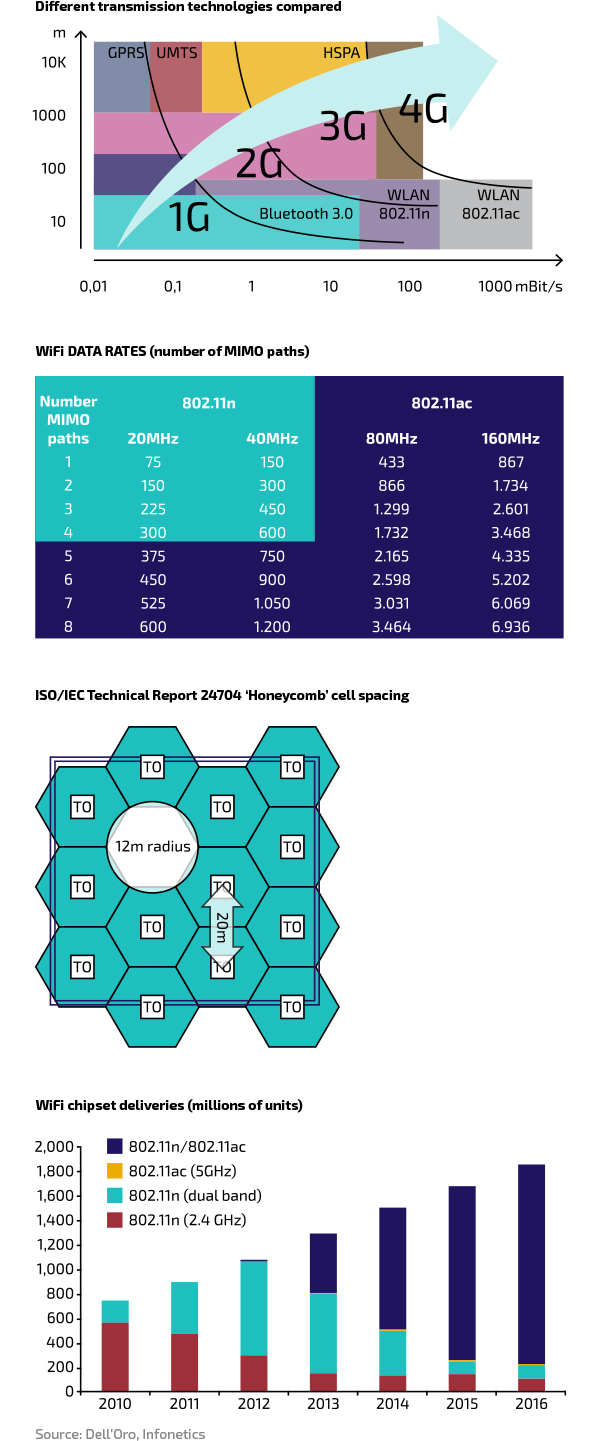Wireless and wired co-existence
However, this won’t happen without the right cabling infrastructure. Increased amounts of data will place higher demands on hardwired infrastructure. To achieve new performance levels, the 802.11ac wireless standard builds on technologies and strategies proven in the earlier 802.11n standard. One of the most significant changes is the fact that wireless will now operate at a higher frequency. Under 802.11n, wireless operates at 2.4GHz. However, this frequency band became crowded by WLAN and industrial applications, resulting in a great deal of signal noise.
802.11ac, however, operates in the 5GHz frequency band, with its wider channel bandwidths, increasing the data rate. 802.11n supports 20 and 40MHz channels, which can deliver data rates up to 150Mb/s. By contrast, 802.11ac supports 20, 40 and 80MHz channels, with optional support for 160MHz. Optional features can achieve data throughput up to 6.9Gb/s, although a high density of access points is required to make this ubiquitous.
Other advantages
802.11ac offers improved modulation, enabling a 33% data transmission rate increase, and support for more spatial streams, allowing multiple inputmultiple output (MIMO) technology. 802.11n can handle up to four streams – for 802.11ac the number of streams is eight, with a maximum of four streams per client. With each additional spatial stream the aggregate data rate increases.
In addition, multi-user MIMO (MUMIMO) allows a single 802.11ac device to simultaneously transmit different user streams on one channel. MUMIMO allows two or more concurrent conversations so an 802.11ac access point could transmit to multiple tablet computers simultaneously. (Firstgeneration 802.11ac product chipsets won’t support MU-MIMO though.) Beamforming technology, optional in 802.11n and the norm in 802.11ac, increases the system’s effective range and lowers signal interference. It allows control circuitry and antennae to create a beneficial interference pattern and transmit radio frequency signal only to where it is needed.
Smart spacing
For uniform, consistent wireless coverage, access points must be spaced regularly. ISO/IEC recommends minimum configuration distances for wireless access points in buildings, supported by Technical Report 24704 (2004), which suggests a dense ‘honeycomb’ cell structure. Each cell has a 12m operating radius, so adjacent access points are separated by 20m.
The Telecommunications Industry Association (TIA) TSB 162 (2006) standard offers similar recommendations. Instead of a honeycomb configuration, the TIA standard is based on square cells with a 13m operating radius and access points 18.3m apart. Revisions to the document, due any day now, include a recommendation for the specification of cabling to wireless access points to be upgraded from Category 5 to Category 6A, which will facilitate 10Gb/s Ethernet connections. The ISO/IEC standard is expected to follow suit shortly.
Regardless of whether a 12m or 13m cell radius is used, both standards recommend linking two high-speed Ethernet cables to each access point as Ethernet cable infrastructure will need to support a wireless LAN longer than the lifetime of one generation of wireless access points. Installing two links helps future-proof the system by ensuring there is sufficient wired network capacity to cope with future increases in data speeds.
Rethinking power
Besides increased data rates, 802.11ac also increases wireless access point power consumption. If units are Power over Ethernet (PoE) compatible, power capacity may need to be reviewed. More importantly, PoE enables installation of a UPS, ensuring higher system reliability.
The 2003 PoE standard IEEE 802.3af defines up to 15.4W output for each device (12.95W net power). The 2009 PoE+ standard IEEE 802.3at almost doubled this to 25.5W output. There is an initiative to further double the power in the next generation PoE. The ISO/IEC TR29125 standard provides guidelines for PoE compatible cabling design, supporting use of Cat.6A cabling which offers better levels of heat dissipation headroom.
Get read for next-generation wireless
In the coming years the increased data capacity of 802.11ac will boost transition to the new standard. Today’s 802.3n hardware is compatible with 802.11ac access points. Thanks to backwardcompatible chip design 802.11ac is likely to be the choice for designers of smartphones, tablets and all kinds of wireless devices to come. This will push down system costs and help 802.11ac penetrate the market. With the huge potential for new wireless applications and services it seems inevitable that 802.11ac will become the default standard for wireless in the next year or two. With this in mind, operators should take every opportunity to upgrade their cable infrastructure, supporting the inevitable switch to next-generation wireless.
Carsten Fehr, Director Product Management for Prysmian Group’s business unit Multimedia Solutions, is primarily active in the optimisation, development and implementation of business models in data communications together with concepts for emerging. He holds degrees in electrical engineering and business administration.
Carsten is a member of the German standards committee UK 412.6, specialising in fibre optic cables and systems, with 18 years of experience in product management and marketing and 6 years in R&D management, working with global vendors in the telecommunication industry.


